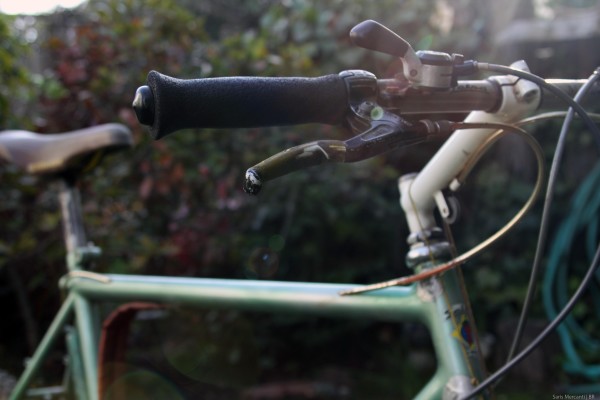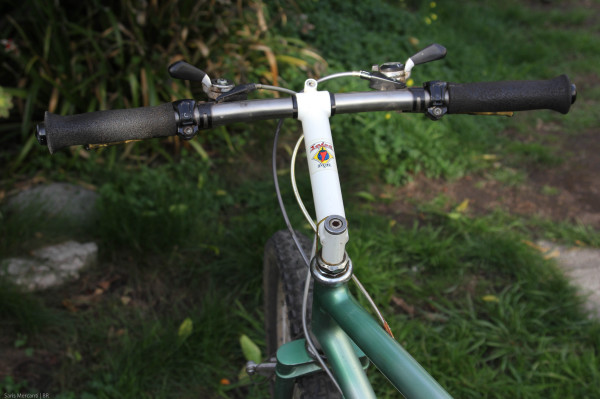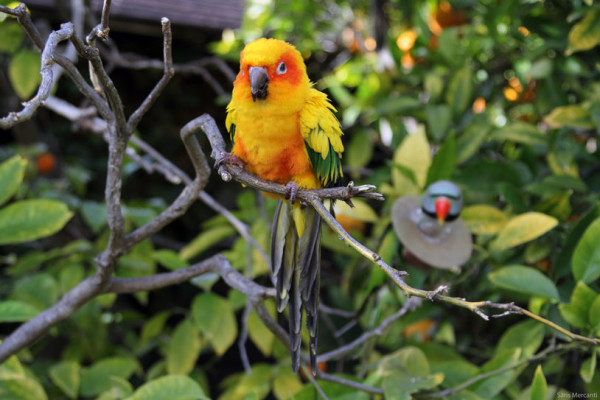A few months ago we shared with you a stunning collection of vintage road bikes, Campagnolo components, and Bruce Lee figurines, that were all carefully curated behind a James Bond style security pad and sliding door. Some of you appreciated the history, other’s wanted more diversity, and another group just hoped that the bikes were let out each day to experience the thrill of the open road.
While we can’t promise to make all of you happy, behind this non-descript wooden gate is an incredible collection of bicycles. They are owned by Mark, who currently lives in Santa Cruz, California, and has deep roots in racing history and local cycling culture. During his professional racing career, he was a member of the first Specialized mountain bike team, he helped test the first Salsa bikes, and he co-owned a local shop which is still a community favorite.
In addition to all of that, Mark is still an avid bike rider, and his garage has a little bit of something for everyone…Including the first Salsa Mountain Bike ever made! So drop past the break to see what lies behind the gate.
 The first time we heard Mark’s name in conversation was in reference to his collection of bikes. He is currently employed by a high end mountain bike manufacturer, and has a reputation for commuting to work on some rather interesting bikes.
The first time we heard Mark’s name in conversation was in reference to his collection of bikes. He is currently employed by a high end mountain bike manufacturer, and has a reputation for commuting to work on some rather interesting bikes.
After seeing the amount of interest generated by our “Dream Garage” article, one of our riding friends suggested that we contact Mark. Phone calls where exchanged and off we went, beer and camera in tow.
 When we arrived, Mark was in the midst of tuning up his Santa Cruz
When we arrived, Mark was in the midst of tuning up his Santa Cruz Solo 5010. This is his current trail bike and is perfect for the vast majority of riding found in the nearby mountains.
 Upon closer inspection, the bike stand proved to be even more interesting than the carbon wonder bike. Constructed roughly a century ago, the Desimone stand (named after a shop of the same name) was built just a half hour away in San Jose, CA an hour drive from San Francisco.
Upon closer inspection, the bike stand proved to be even more interesting than the carbon wonder bike. Constructed roughly a century ago, the Desimone stand (named after a shop of the same name) was built just a half hour away in San Jose, CA an hour drive from San Francisco.
For most of the year, the stand lives indoors, but it suns out/stands out in this backyard.
 Inside the shed is a collection of antique, vintage, and modern bikes that would make the heart of almost any cyclist go pitter patter. Perhaps the most interesting is this particular bike, because it’s the first mountain bike built by Ross Shafer under the Salsa brand.
Inside the shed is a collection of antique, vintage, and modern bikes that would make the heart of almost any cyclist go pitter patter. Perhaps the most interesting is this particular bike, because it’s the first mountain bike built by Ross Shafer under the Salsa brand.
That’s right, this is Salsa #1. There are many other Salsa bicycles, but this is the first one.
In the late 70s and early 80s, Shafer worked for Santana Bicycles in Southern California building lugless tandem frames. During that time, the majority of custom frames were constructed from lugs, which due to the manufacturing process limited the geometry of the final product. Using the skillset he learned building tandems, Ross built his first lugless mountain bike with input from the geometry experiments being performed by Southern California builders like Richard Cunningham at Mantis bikes.
As the story goes, Ross came to visit Mark with the frame in Santa Cruz for a friend’s wedding, and wanted to build the new bike up immediately. Even though the parts for the build hadn’t arrived, Ross was so eager to get the frame built up (and who hasn’t been there), that he convinced Mark to build the bike with whatever parts he had laying around! So in it’s first iteration, the bike was built with a Campi road group.
 Over the years the frame has gone through many different builds as Mark sought lighter parts, broke them, mountain bike specific components were invented, and he prototyped and tested others for sponsors.
Over the years the frame has gone through many different builds as Mark sought lighter parts, broke them, mountain bike specific components were invented, and he prototyped and tested others for sponsors.
The initial build weighed roughly 31.5 lbs, and it was eventually as light as 29 lbs and change, but the current build and it’s mostly era specific parts, weights ~30 lbs.
As a top level racer and factory sponsored athlete, Mark provided valuable insight to companies at the beginning of the mountain bike era. One of his pet peeves at the time was the long moto style brake-levers found on most early mountain bikes, so he sourced these shorter brakes-levers from Diacompe that had originally been made for BMX bikes.
 Built in 1982, before over-sized bicycle tubing was invented, the only butted tubing available was for road bikes. So when put to the rigors of early off road racing, the material often broke. Both the original downtube and the fork blades have had to be replaced with materials sourced for Tandems.
Built in 1982, before over-sized bicycle tubing was invented, the only butted tubing available was for road bikes. So when put to the rigors of early off road racing, the material often broke. Both the original downtube and the fork blades have had to be replaced with materials sourced for Tandems.
 Mountain bike racing was a different beast thirty years ago. Instead of pedaly downhill races with timed descents, the races where brutal physical adventures, that often has carrying portions.
Mountain bike racing was a different beast thirty years ago. Instead of pedaly downhill races with timed descents, the races where brutal physical adventures, that often has carrying portions.
So Mark’s Salsa was built with internal routing to make shouldering easier, and also had a carry strap attached to the frame.
 While the recent trend towards larger frames is motivated by a desire for increased stability and the popularity of Enduro everything, things were different in the late 80s, where off road cyclists often preferred smaller frames for better top tube clearance in technical riding conditions. Bucking that trend, Mark actually preferred a slightly larger frame, because it made carrying the bike cyclo-cross style easier.
While the recent trend towards larger frames is motivated by a desire for increased stability and the popularity of Enduro everything, things were different in the late 80s, where off road cyclists often preferred smaller frames for better top tube clearance in technical riding conditions. Bucking that trend, Mark actually preferred a slightly larger frame, because it made carrying the bike cyclo-cross style easier.
In addition to mountain bikes, Mark also enjoys riding cyclocross. He frequently races this bike locally, but also has another cyclocross build in the works, which we’ll cover later in the post.
This is the original logo of the Bicycle Trip bike shop.
The threaded headset gives away the frame’s vintage, but what’s unique about the build is the fork. Mounted to the front is a prototype Bontrager unit with clamp style crown, that Mark has JB welded spacers to for a better stance. These modifications were made to the bicycle because he wanted something that was burlier and could track through corners better, etc..
Mark often gave Keith Bontrager, another Santa Cruz resident, test feedback and many of these older prototype forks are in his shed. The benefit to this clamp style moto fork is that the fork blades can be easily swapped out, which made it easy to test out different geometries relatively quickly.
On the commercial side of things, the oversized aluminum uni-crown also allowed riders to replace fork blades if they were mangled in a crash, and even tune their ride handling characteristics.
Speaking of Bontrager, Mark had to pull this bike out of the shed. It was originally built for touring, is currently set up as a single speed, but has seen many different iterations.
Designed to be setup with either 700c or 26″ wheels, there are two sets of brake mounts. At the time, that should have meant there were two sets of brake post mounts sticking out from the frame, but Keith had just developed removable brake boss mounts.
For daily commuting, Mark generally rides an older Austrian 3 speed cruiser built by Steyr, who originally built bikes for Sears under the J.C. Higgins brand. The frame is rusted in spots and the chain is chipping, but the brand was very popular among early mountain bikers because the forks did not bend as easily when jumping water bars, and other klunking tom foolery.
Rather than drag the tired looking townie out for glamour shots, Mark introduces us instead to his latest commuter project.

Built by an English firm named Rex, the rear-hubs has a manufacturing date of 1973, but the bike sat brand new, unassembled, in a box until recently. It was a fairly entry-level model at the time, but features beautiful details and a classic paint scheme.
At the time the Rex bike was new, the English bicycle industry was protective about using parts made exclusively in England, so to enter that market many companies like Michelin set up factories in the UK.
Despite the fact that this model was made in the early 70s, the bike looks very similar to those manufactured just after WWII. Until the boom in bicycle popularity of the late 60s and early 70s, bicycle design stayed mostly the same for many years.
Mark’s shed is packed with frames, some of which were more accessible than others, but this Italian bike was sitting conveniently by the door.
While not familiar to the modern rider, Bottecchia once made a full range of bicycles, and Greg Lemond won the 1989 Tour de France on one of the company’s higher end models.
Hanging just a little further in the shed was this brand new Rock Lobster frame, which has a steel front triangle and carbon seat stay. This should be a blast for the next cyclocross season!
Hanging off this frame is an early example of a San Jose Bike License
In addition to the bikes we covered, there were also bikes we just couldn’t conveniently access. We really should have tried harder to pull down that track bike that raced in the 1968 Olympics…
And for making it through to the end, here’s a picture of one of Mark’s two winged friends…


















